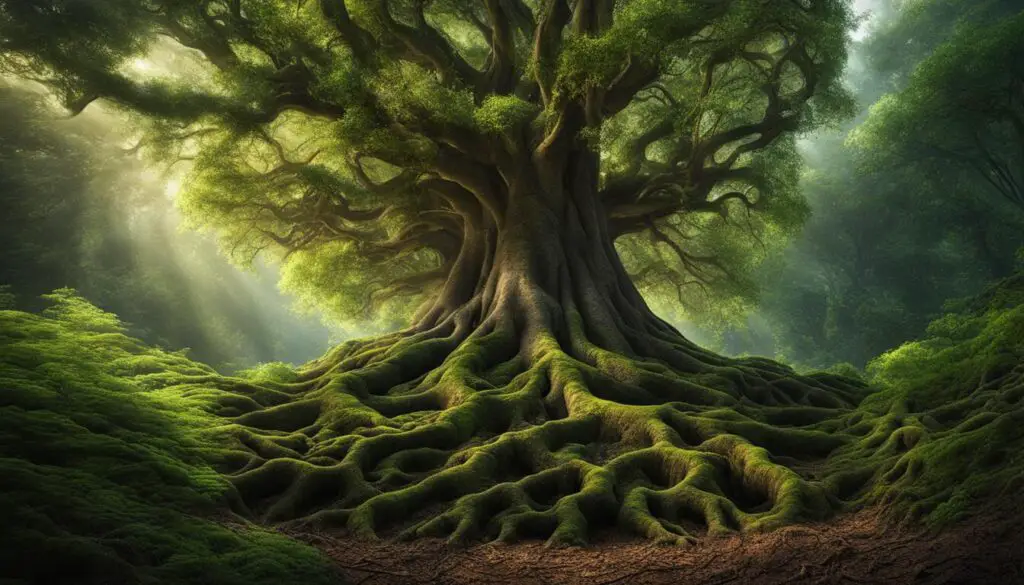Welcome to our exploration of the fascinating world of tree reproduction. Have you ever wondered how these majestic beings create new life and continue to thrive? Join us as we delve into the intricate process of tree propagation and uncover the hidden secrets behind their reproductive cycle.
Key Takeaways:
- Trees reproduce through a process called tree propagation.
- Pollination is the first stage, where pollen is transferred to female reproductive organs.
- Fertilization occurs when pollen grains fuse with ovules in the pistil.
- Seeds are dispersed through various methods like wind, animals, or water.
- Under favorable conditions, seeds germinate, giving rise to new trees.
The Role of Seed Dispersal in Tree Reproduction
Seed dispersal plays a crucial role in the reproductive cycle of trees, ensuring the survival and diversity of their species. After the process of fertilization, trees produce seeds that need to be dispersed away from the parent tree to prevent competition for resources and promote the establishment of new trees in different areas. Various mechanisms facilitate seed dispersal, allowing trees to colonize new habitats and maintain healthy populations.
One common method of seed dispersal is wind dispersal. Trees have developed specialized structures, such as wings or parachutes, that enable their seeds to be carried by the wind over long distances. This mechanism allows seeds to reach new locations and take advantage of unoccupied niches for growth. Animal dispersal is another important method, where seeds are consumed by animals, pass through their digestive system, and are then deposited in new areas through their droppings. This symbiotic relationship between animals and trees ensures the dispersion of seeds to diverse habitats.
Water dispersal is yet another mechanism utilized by certain tree species. Seeds may have adaptations that allow them to float on water or be carried by flowing water, such as rivers or streams. In this way, trees can reach distant areas and establish themselves in different environments. Once the seeds reach a suitable environment, they undergo germination, a process where the seed sprouts and develops into a new plant. Germination is influenced by factors such as temperature, moisture, and light availability, and it marks the beginning of a new tree’s life cycle.
The diversity of seed dispersal methods:
- Wind dispersal: Seeds are carried by the wind over long distances.
- Animal dispersal: Seeds are consumed by animals and dispersed through their droppings.
- Water dispersal: Seeds float on water or are carried by flowing water.
By employing various seed dispersal methods, trees ensure their widespread distribution and increase the chances of successful reproduction. This diverse range of dispersal mechanisms contributes to the resilience and adaptability of tree populations, allowing them to thrive in different habitats and environmental conditions.
In summary, seed dispersal is a vital process in tree reproduction. Through wind, animal, and water dispersal, trees can scatter their seeds far and wide, reaching new areas and establishing themselves in diverse environments. This dispersal is essential for maintaining genetic diversity, colonizing new habitats, and ensuring the long-term survival of tree populations. By understanding the mechanisms behind seed dispersal, we can appreciate the remarkable adaptations and strategies that trees have developed to propagate and thrive in the natural world.
The Fascinating Role of Trees in the Ecosystem
Trees play a vital role in the ecosystem through their unique reproductive strategies and organs. They have evolved various methods of reproduction to ensure the survival and diversity of their species. Some trees rely on cross-pollination, a process where pollen is transferred between different individuals of the same species. This promotes genetic diversity and enhances the adaptability of tree populations to changing environments.
Other trees have developed mechanisms for self-pollination, allowing them to reproduce even when there are no other individuals nearby. This ensures the continuity of their species, especially in isolated or fragmented habitats. Trees also possess specialized reproductive organs, such as flowers, which attract pollinators like bees, butterflies, and birds. These reproductive organs facilitate the transfer of pollen and increase the chances of successful fertilization.
“Trees have developed remarkable strategies to ensure their reproduction and contribute to the overall biodiversity and balance of the ecosystem.”
The Importance of Tree Propagation Methods
Trees employ various propagation methods to disperse their seeds and establish new individuals. Wind dispersal is a common mechanism, where trees produce lightweight seeds equipped with structures like wings or hairs that enable them to travel long distances with the help of wind currents. Animal dispersal is another strategy, as animals consume fruits or seeds and then disperse them through their droppings, allowing for seed dispersal in new areas.
Water dispersal also plays a role in tree reproduction. Seeds that are dispersed by water can travel along rivers, streams, or lakes, reaching different environments that may be suitable for germination. These propagation methods ensure that tree populations can expand their range, colonize new habitats, and maintain genetic connectivity, enhancing their resilience and adaptability in the face of environmental changes.

“Understanding tree reproduction strategies and propagation methods is crucial for the conservation and sustainable management of tree species.”
The Hidden Communication Among Trees
Trees have a remarkable ability to communicate and interact with each other. They form complex social networks underground through mycorrhizal networks, where fungal filaments connect the roots of different trees. Through these networks, trees can share resources, such as water and nutrients, and communicate with each other.
They send signals to warn neighboring trees about potential dangers, such as insect attacks or drought conditions, allowing the trees to respond accordingly. Trees also communicate through the release of chemical signals and scents, which can attract beneficial insects or repel herbivores. These hidden forms of communication contribute to the overall health and resilience of the forest ecosystem.
Tree Social Networks
The underground mycorrhizal networks serve as tree social networks, enabling trees to establish connections and communicate with each other. These networks facilitate the exchange of information and resources, promoting the collective well-being of the forest community.
“Trees are able to send warning signals to their neighboring trees, alerting them to the presence of threats and allowing them to mount a defense. It’s like a secret communication system hidden below the surface.”
Tree Signaling
Tree signaling involves the transmission of information through chemical signals, scents, and electrical impulses. When a tree is under attack or experiencing adverse conditions, it can release specific chemicals or volatile organic compounds (VOCs) to warn nearby trees. These signals prompt neighboring trees to activate their defense mechanisms and adapt to the changing environment.
- Tree communication helps in the collective defense against pests and diseases.
- By sharing resources and information, trees can optimize their growth and increase their chances of survival.
- The interconnectedness of forest ecosystems through tree communication contributes to their overall resilience and adaptability.
The hidden communication among trees showcases their remarkable ability to cooperate and support each other, contributing to the overall health and equilibrium of the ecosystem.
The Intelligence and Adaptability of Trees
Recent scientific research has shed light on the remarkable intelligence and adaptability of trees. Far from being static beings, trees possess an intricate network of communication and the ability to respond to their environment. They exhibit a level of awareness and resourcefulness that is both fascinating and essential for their survival.
Trees demonstrate their intelligence through various mechanisms. For example, they can sense changes in light, temperature, and moisture levels, and adjust their growth patterns accordingly. This allows them to optimize their energy allocation and maximize their chances of survival. Additionally, trees have the remarkable ability to release chemical signals that deter herbivores or attract beneficial insects. This demonstrates their adaptive response to potential threats and their ability to form symbiotic relationships for their own benefit.
Furthermore, trees possess built-in survival strategies that contribute to their adaptability. When a tree is wounded, it allocates resources to the injured area in order to promote healing and prevent further damage. Trees also have the ability to shed leaves or branches in response to unfavorable conditions, conserving energy and ensuring their long-term survival.
Ultimately, the intelligence and adaptability of trees allow them to thrive in various ecosystems and contribute to the overall health of the planet. By understanding and appreciating the remarkable abilities of trees, we can better appreciate their role in the environment and strive for their conservation and protection.

The Importance of Tree Reproduction for the Planet
Tree reproduction is a vital process that holds immense ecological significance for our planet. Trees are not just beautiful and majestic; they also play a crucial role in maintaining the health and balance of ecosystems. Understanding the intricacies of tree reproduction is essential for effective tree conservation efforts and ensuring a sustainable future for generations to come.
Trees are true superheroes of the natural world, providing us with essential ecosystem services that are irreplaceable. Through the process of photosynthesis, trees produce oxygen, helping to maintain the air we breathe. They also act as carbon sinks, absorbing carbon dioxide from the atmosphere and mitigating climate change. In addition, trees serve as habitats for countless species, supporting biodiversity and promoting a healthy ecosystem.
By focusing on tree reproduction, we can actively contribute to the conservation and preservation of these invaluable resources. Protecting mature trees and their reproductive processes allows them to produce seeds and ensure the regeneration of forests. This, in turn, supports the restoration of degraded areas, enhances wildlife habitats, and strengthens the resilience of ecosystems.
Tree conservation efforts are crucial not only for the survival of individual species but also for the overall health and functioning of our planet. By appreciating and promoting tree reproduction, we can make a significant difference in preserving the ecological balance and securing a sustainable future for ourselves and the generations to come.
FAQ
How do trees reproduce?
Trees reproduce through a process called tree propagation, which involves stages such as pollination, fertilization, seed dispersal, and germination.
What is seed dispersal and why is it important?
Seed dispersal is the mechanism by which trees spread their seeds away from the parent tree. It is important to prevent competition for resources and promote the survival and diversity of tree species.
How do trees contribute to the ecosystem?
Trees play a vital role in the ecosystem through their reproductive strategies and organs. They provide essential ecosystem services, such as oxygen production, carbon sequestration, and habitat creation.
How do trees communicate with each other?
Trees form complex social networks underground through mycorrhizal networks and communicate through chemical signals and scents. They can share resources, warn neighboring trees about dangers, and promote overall forest health and resilience.
Are trees intelligent and adaptable?
Recent scientific research has revealed that trees possess intelligence and adaptability. They can sense and respond to their environment, adjusting their growth patterns and resource allocation accordingly.
Why is tree reproduction important for the planet?
Tree reproduction is crucial for the regeneration and sustainability of forests, which are essential for mitigating climate change and maintaining biodiversity. Supporting tree reproduction is vital for a sustainable future.

